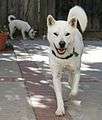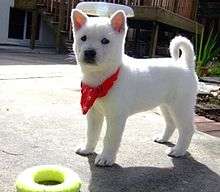Kishu
 | ||||||||||||||||||
| Other names |
Kishu-Ken Kishu-Inu | |||||||||||||||||
|---|---|---|---|---|---|---|---|---|---|---|---|---|---|---|---|---|---|---|
| Origin | Japan | |||||||||||||||||
| ||||||||||||||||||
| ||||||||||||||||||
| Notes | Also JKC and NIPPO recognized - AKC, FCI, and UKC information in the cut. | |||||||||||||||||
| Domestic dog (Canis lupus familiaris) | ||||||||||||||||||
The Kishu (紀州犬 Kishū-Inu), sometimes called Kishu Ken or Kishu Inu, is a Japanese breed of dog, developed there for thousands of years. It is descended from ancient medium-sized breeds and named after the Kishu region, now Mie Prefecture and Wakayama Prefecture. This breed is similar to the Hokkaido, Shikoku and the Kai Ken. Sometimes it is mistaken for the white variant of Hokkaido because of very similar appearance. The Japanese originally used this breed of dog for boar and deer hunting. Like the Shiba, they are often quiet. Kishu will stalk prey quietly rather than bark.
Description
Appearance


The Kishu stands 17-22 inches (43–55 cm) tall, averages 30–60 pounds and is considered a medium-sized dog. The standard only permits solid colored dogs to be shown. Accepted show colors are white, red, or sesame. Although no color is officially preferred, white has become most common in recent decades. The nose color is primarily black, but with the white coat the nose can be brownish or pink in color. The bite is either scissor or a level bite. The tail is either carried in a sickle or curled over the back like that of an Akita or Shiba Inu. The coat is short, straight, and coarse with a thick undercoat. There is fringe on the cheeks and tail. The ears incline forward and are smaller rather than larger. This breed is tough, agile, and friendly.[1][2][3]
Temperament
Kishu Kens are a one person/one family dog. They are courageous and brave as hunters, and will be loyal to their owners. They have a strong prey drive, and will hunt small animals. A few have been known to do well with cats if raised with them. They do well with other dogs if socialized well as puppies, however, due to their pack instincts they might cause some fights for dominance. They are quite headstrong and willful, making training necessary, but they are devoted and loyal to family, getting along well with children, if raised with them. Kishu Kens like to keep an eye on whatever is going on, and sometimes find a high place to look out from. They can be aloof or shy around strangers. They are easily housebroken, intelligent, and strong willed.
Health
Health problems with the Kishu Ken are occasional hypothyroidism (low thyroid), which is not uncommon among the Japanese breeds, and affects perhaps one in ten dogs. It is not life-threatening and treatment is a thyroid pill daily for the optimum health of the dog, as with humans. Food and environmental allergies are not uncommon in the Kishu Ken.[4]
The other known issue is entropion, a genetic defect affecting the eye in which the eyelid turns inward and the lashes scratch the eyeball. This is connected in part to the triangular shape of the eye in the Kishu Ken. This requires surgery to prevent the loss of vision in the eye and continual pain to the dog.
Grooming
The Kishu should be brushed weekly to keep their fur mat free and clean. Bathe them as necessary, depending on how dirty they are. Their ears should be checked routinely for wax build up, infection or dirt. Their nails should also be trimmed regularly. Kishu Kens shed once or twice a year, making grooming at these times needed.
Exercise
The Kishu needs adequate space to roam and exercise, meaning a house with a yard or urban environment with a fence. They need regular exercise on a leash, taking walks or runs. They can also be given a job to do such as herding to satisfy their exercise.
Competition
Kishu Ken do well in obedience, rally, and agility competitions due to their intelligence and strong athleticism.
History
A study in the 1930s carried out by a Japanese breeder, Haruo Isogai, classified all native Japanese dog breeds into three categories: large-, medium-, and small-sized. The Kishu Ken belongs the medium-sized dog group. Other medium-sized dogs are the Kai Ken, the Hokkaido Ken, and the Shikoku Ken. They are all very similar with overlapping colors and only minor differences in size and morphology.[5]
Kishu Ken are a primitive dog that was selectively bred for the hunting of wild boar and deer in the mountainous Mie prefecture and Wakayama prefecture. The breed was not standardized until 1934 and was composed of the dogs collected from that area. When the breed first started, approximately 70% of individuals were said to be non-white. The popularity of a primarily white line of Kishu Ken spread the gene responsible for white through the genepool and turned the Kishu Ken into the mostly-white breed it is today.[6]
The Kishu is a Foundation Stock breed with the American Kennel Club. The American Kishu Registry is the official Kishu registry in the United States and is recognized as such by AKC. Other registries include Japan Kennel Club (JKC) and Nihonken Hozonkai (NIPPO), both in Japan. The Nihon Ken Hozonkai is considered the main registry of the breed in its parent country and is responsible for the original breed standard.[7] The Kishu has been recognized as a natural monument of Japan since 1934. Since this breed is so rare in North America and Europe, you may only get a chance to see it in its native homeland, Japan.
Breeders are uncommon outside Japan. There are a handful of breeders in the United States and the Czech Republic. Breeders also exist in the Netherlands, Russia, Poland, and Finland.[8]
Manga
The works of manga artist Yoshihiro Takahashi feature many Kishu, characterizing them as skilled fighters.
- Akame of Ginga: Nagareboshi Gin
- Kyōshirō of Ginga Legend Weed. Also Sakura, the main character's mother, was a Kishu. This makes Weed, the main character, a Kishu/Akita mix—his father Gin was an Akita Inu.
- Gamu, Kusakage, Shiba, Tsuchigumo, Oboro, and Honō, the Ganin warriors of Kacchū no Senshi Gamu.
Gallery



 Kishu Inu
Kishu Inu





See also
References
External links
| Wikimedia Commons has media related to: |
- Japan Dog Export
- The Nihon Ken Blog
- The Nihon Ken Forum
- Nihon Ken Hozonkai (NIPPO) (Japanese only)
- American Kishu Registry